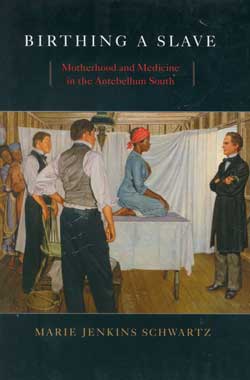Enslaved Bodies, Enslaved Selves


In 1834, South Carolina slaveholder James Henry Hammond composed a detailed guide for plantation management. He offered a series of suggestions, large and small, on topics ranging from crop production to animal husbandry. Enslaved women’s reproductive health in particular—pregnancy, childbirth, and breast feeding—fascinated Hammond, a self-proclaimed expert on homeopathic medicine. No detail of the “peculiar institution” was too private for his public observations. Despite his own lack of medical training, he advised slaveholders that with the appropriate manuals and materials, they too could manage their bondswomen’s reproductive lives. In Birthing a Slave: Motherhood and Medicine in the Antebellum South, historian Marie Jenkins Schwartz explores precisely this struggle over enslaved women’s bodies: between slaveholders like Hammond, the physicians they hired, and the enslaved community’s folk traditions.
After the United States withdrew from the transatlantic slave trade in 1808, planters like Hammond recognized that the institution of slavery depended upon enslaved women’s ability to reproduce. “During the antebellum era,” as Schwartz explains, “the expectation increased among members of the slaveholding class that enslaved women would contribute to the economic success of the plantation not only through productive labor but also through procreation” (11). While scholars have acknowledged this defining characteristic of nineteenth-century American slavery, the intricacies of the subject have been surprisingly unexplored, at least until now. As Schwartz makes clear, in the decades preceding the Civil War, slaveholders eager to expand their labor force took active, often coercive, steps to increase the number of children “born into bondage” (1). They commissioned southern physicians to tend to their bondswomen’s reproductive health. Such doctors, eager to expand their patient pool and to demonstrate their expertise, monitored slave pregnancies and childbirths and attempted to treat a range of bondswomen’s reproductive ailments: infertility, menstrual difficulties, gynecological cancers, and postpartum complications. Slaveholders like Hammond and the doctors they hired couched such interventions in the language of paternalism. “Professional” medical care ostensibly evinced a master’s concern for his enslaved property.
Yet masters’ efforts to provide reproductive medicine often collided with the preferences of enslaved women, who commonly favored traditional healing practices over “modern” intervention. Whenever possible, expectant enslaved mothers looked to other bondswomen for help with pregnancy and delivery. But, as Schwartz notes, masters and plantation doctors often ignored an enslaved mother’s wishes, privileging her life and ability to reproduce over the life of her unborn child. Plantation doctors understood that they worked for the slaveholder, not the patient, and elevated their reputations over their patients’ desires. Ultimately, enslaved women struggled to make medical choices “in a society that did not define control of one’s body as a fundamental right of slaves” (3).
Schwartz organizes Birthing a Slave “thematically around a woman’s reproductive life: fertility, pregnancy, childbirth, postnatal complications, gynecological disorders, and the related topic of cancer and other tumors” (6). Each of these sections illustrates the manifold ways the system of slavery affected black women’s spiritual and physical well-being. The crude, often dangerous realities of nineteenth-century medicine wreaked havoc on black women’s bodies. Schwartz’s detailed discussion of gynecological cancers is especially good at exposing this tragic reality of antebellum slave life, when planters privileged black women’s economic worth and surgeons prioritized medical breakthroughs at the expense of black women’s comfort, even at the end of these patients’ lives. A more perfunctory closing chapter, “Freedwomen’s Health,” sketches how medical relationships between white doctors and black female patients evolved after emancipation, when physicians fled their practices to fight for the Confederacy, and under Jim Crow, when a resurgence of racial animosity impeded black women from receiving professional medical care.
The swiftness of the last chapter notwithstanding, Birthing a Slave is painstakingly researched and meticulously documented. Schwartz withholds no detail about enslaved women’s gynecological health from her readers, no matter how graphic. The agonies of childbirth before the advent of anesthesia; the black market for stillborn and aborted fetuses; and ovarian, uterine, and breast cancers before modern pain management are each unearthed with uncommon archival capability. Drawing upon antebellum physicians’ case histories, medical records, and published journals; slaveholders’ plantation records and account books; and the recollections of former slaves and their descendants, Schwartz reconstructs an exhaustive portrait of some of the most intimate—and important—details of antebellum slave life (6-7). Her historical intrusiveness is the perfect analogue for the ways slave owners and physicians poked and prodded enslaved women (33).
As Schwartz convincingly demonstrates, the history of reproductive health touches upon nearly every debate that has dominated slavery studies over the past several decades: resistance and agency, hegemony, paternalism, family, culture, and religion. For its historiographical reach, analytical breadth, and archival depth, Birthing a Slave will be of great interest to scholars of African American history, southern history, women’s history, and the history of medicine. This book is impeccably researched and beautifully written. Schwartz has admirably tackled a sensitive subject with analytical grace and narrative skill. While it may not be the right book to savor over a morning coffee, Birthing a Slave is social history at its finest.
This article originally appeared in issue 7.2 (January, 2007).
Hilary Moss is an assistant professor of history and black studies at Amherst College. She is currently completing a book manuscript on race, citizenship, and education in antebellum America.